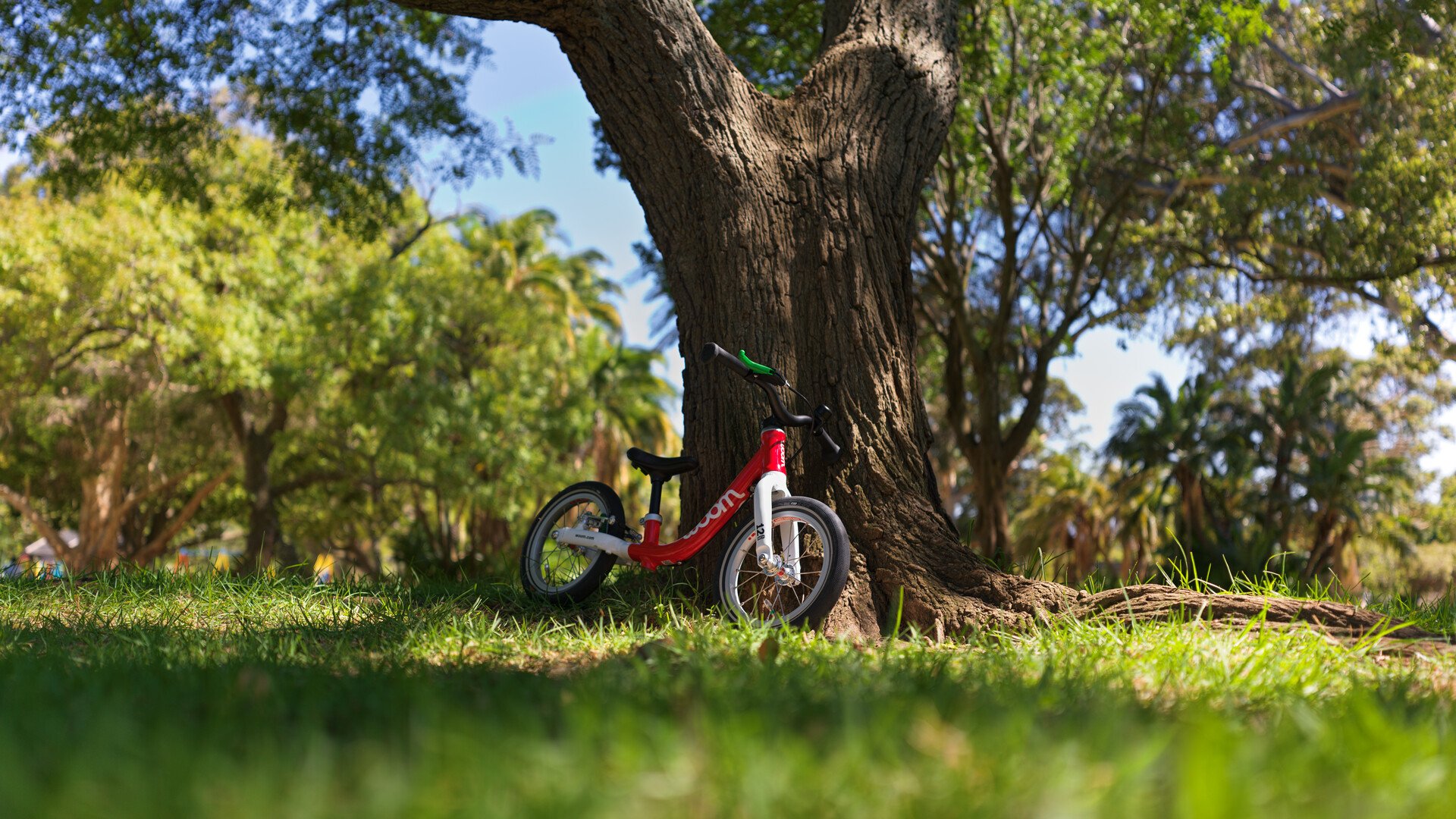How to start riding a bike (& loving it)
Find out how best to support your child as they learn to ride a bike.


Look, I'm riding! There’s something truly magical about a child’s first few unsupported meters on a bike! In fact, it’s hard to know who is most proud – the onlooking adults or the child?
Apprehension is entirely normal when kids get started. They may be fearful of falling and express some hesitation. This is why it's even more important to create the safest-possible environment for your child while they're practicing. Here are our top tips:
- Riding a correctly sized child-specific bike guarantees safety and smiles. But it also drastically improves the speed with which your child will pick up the skills. Our superlight woom GO is ideal for children who are learning to ride a bike.
>>Read this article to find out what makes a good child-specific bike.
- Tumbles are inevitable.
But a little crash should not result in injuries. For this reason, your child should always wear a helmet! It needs to fit and sit perfectly – just like our innovative, safety-conscious READY Kids' Helmet does.
Cycling gloves and elbow protectors are sensible for added protection from bruises and scratches. They will also boost your child’s confidence. - Pick somewhere suitable to practice.
Pick a practice area that's away from traffic and free of any potentially stress-inducing elements. Look for a courtyard, park or pedestrianized road.
- No stabilizers, please!
Just because rickety training wheels were once the norm, that doesn't mean they should be inflicted on the current generation of kids.
Fact. Training wheels make learning to ride more difficult.
By riding with training wheels, your child is granted a false sense of security, which ultimately has a counterintuitive effect on how they develop their balance skills. When it comes to transitioning to a bike, your child will have to learn balance and stability all over again.
We therefore stand by our recommendation:
Always begin on a balance bike!
It's all about learning through play. On a balance bike, kids are acquainted with the fundamentals of cycling in the most fun way imaginable and get a gentle introduction to just how good it feels to glide over the ground.
- In their earliest attempts, your child will probably keep their feet on the ground or simply prop the balance bike between their legs and shuffle along.
- But once their confidence grows, they’ll begin to lift their feet off the ground more often as they train their sense of balance.
- Within no time at all, your child will be able to cover increasing distances, continuing to develop their balance skills at speed and even braving some changes in direction.
- We highly recommend that >> their balance bike is equipped with a child-specific hand brake lever – this introduces them to hand-operated braking right from the start, which means one less skill to learn when they move up to a pedal bike.
Sturdy shoes are also important because kids tend to use their feet for braking at the beginning.
On your pedals, get set, go!
Once your child has perfected their balance biking, the only thing left to learn is how to turn the pedals. But don't worry – even if your child is not a balance bike graduate, this will not stop them from making a success of it.
Here's what to do:
1. A quick, preparatory step
Show your child how pedaling works.
Do this by lifting the rear wheel and turning the cranks. This shows your child how the cranks and rear wheel work together.
Now show them what happens to the front and rear wheel when you brake.
2. Be encouraging
Your child may be a little wound-up before their first real attempt at riding – and that's totally okay.
You can boost their confidence by gently resting your hands on their shoulders or supporting their saddle as you run or walk alongside them. Once they pick up some speed, they’ll balance without realizing it!
3. The magic moment
When balancing and pedaling meet in sync, your support will no longer be needed – now is the time to raise your hands as your child rides on their own.
Jog alongside them to help them stop safely or to keep them upright and prevent a crash if they look as though they're at risk of toppling to one side.
4. Coming to a solo stop
Continue to sharpen their skills by introducing the idea of braking correctly after a few more tries. Encourage them to use the brake levers first and then put their feet on the ground.
5. Setting off solo
Your child's dominant leg needs to be on the pedal at one o'clock when they’re ready to push off.From here, your child pushes down on the pedal while raising the free leg off the ground at the same time.
Alternatively, your child can try a rolling start – like on a balance bike – and simply raise their feet onto the pedals when they have reached a good speed.
A gentle downhill slope will make setting off easier at this stage.
Remember to remain calm and encouraging throughout this phase. Not all children pick it up immediately, so you can help by being reassuring and patient.
For some kids, it might be a good idea to split practice time into manageable chunks. Your child may not yet be ready to dedicate their full attention to learning everything there is to know.
Play into a child's natural curiosity by practicing in a location where there are lots of kids on bikes – this will allow them to observe, grow excited and imitate.
When's the right time for a child to learn to ride?
Young children are yet to fully develop their cognitive and motor processes. This includes skills that are fundamental to cycling – such as keeping balance, dexterity of hands and fingers, reaction times and sense of orientation.
The right moment depends less on a child’s age and more on their current state of development. Some kids learn at the age of three or four, while others won't get going until they're primary school age.
If you try to rush the process with a child that lacks sufficient motor skills, there's a risk that it becomes too much like hard work or – worse still – they develop a sense of fear or anxiety at the prospect of riding a bike. In such cases, it's best to put the pedals on ice for a while longer.
We suggest that your child keeps having fun on their balance bike until they're truly ready for the transition.
In general, the speed of your child’s learning should be dictated by their motivation and fueled by their inspiration for two wheels. Attempting to speed up this process through pressure could have the opposite effect.
If you include your child in the family passion for bike rides from a very young age – whether in a child's seat or bike trailer – they are highly likely to develop a genuine fascination for cycling, simply by being in the moment and surrounded by two wheels.















